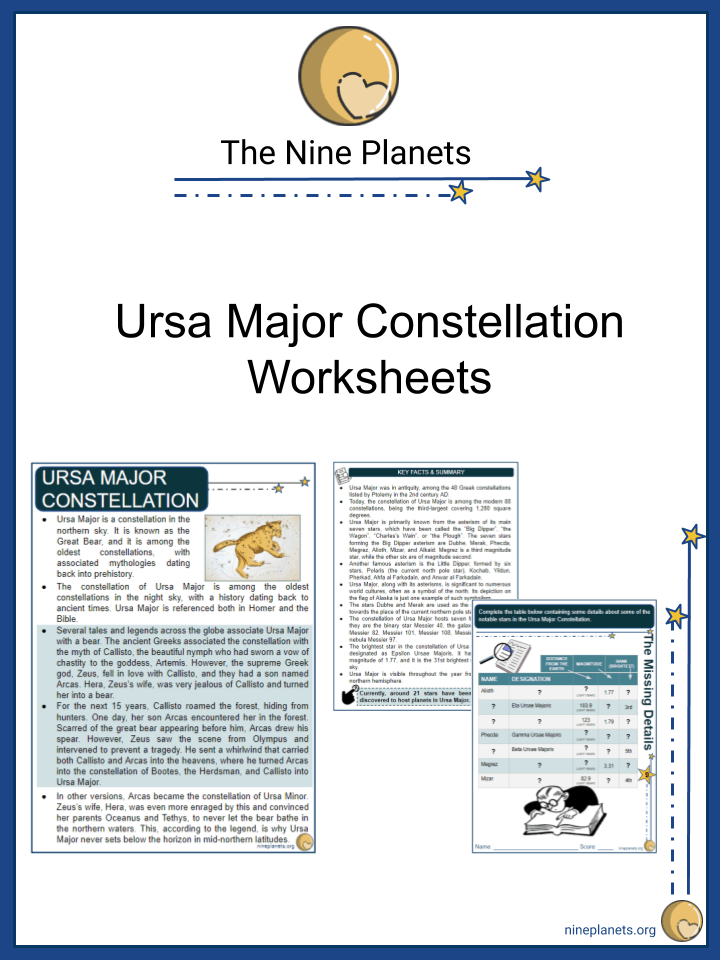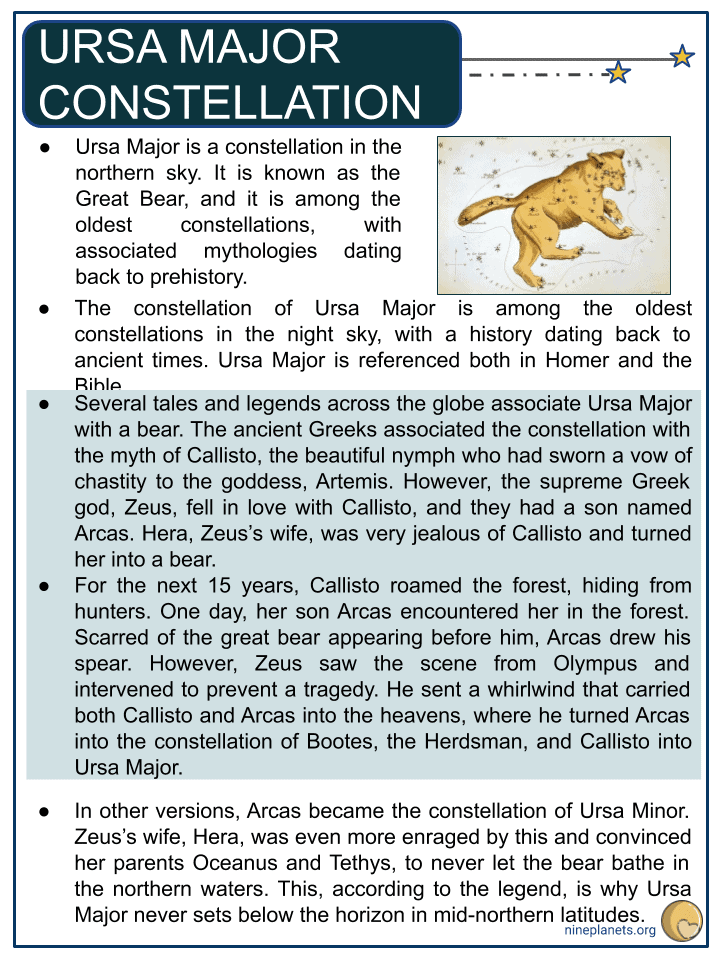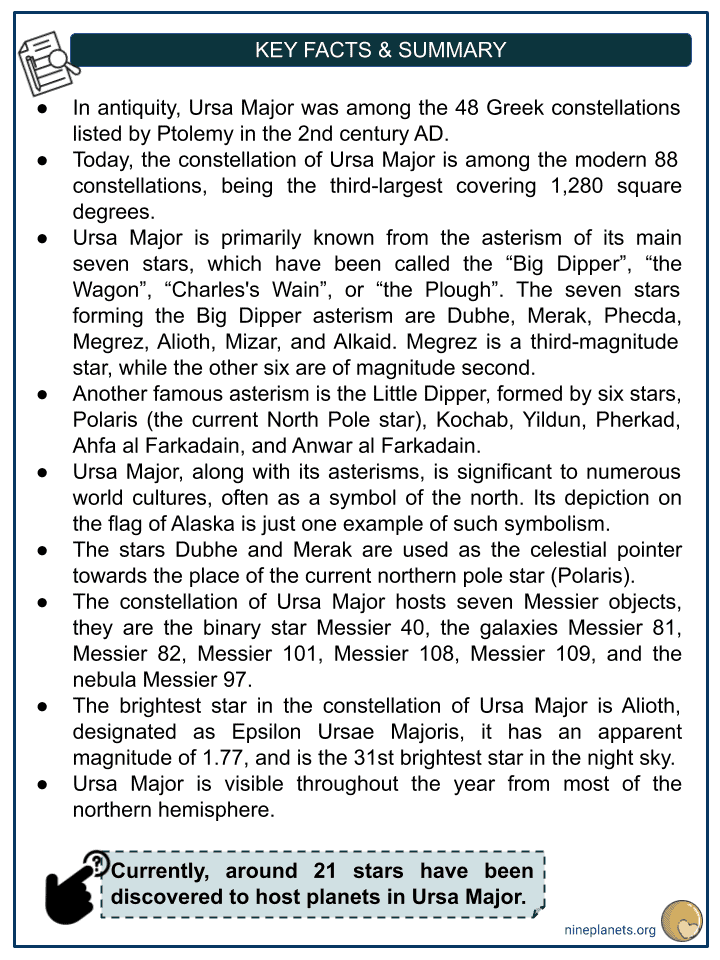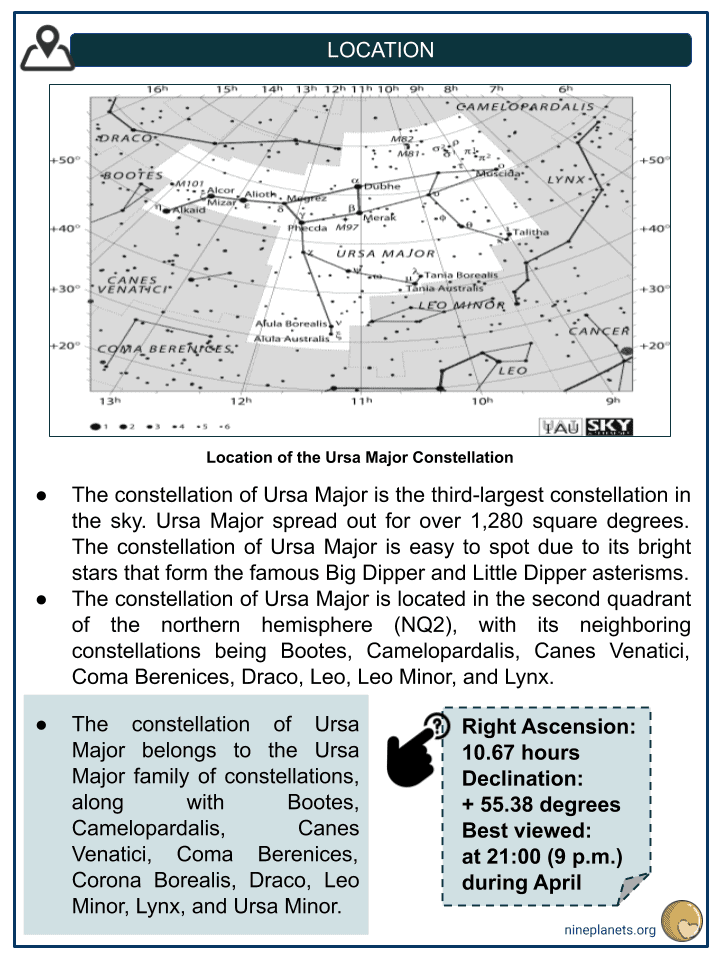Download Ursa Major Constellation Worksheets
Click the button below to get instant access to these premium worksheets for use in the classroom or at a home.

This worksheet can be edited by Premium members using the free Google Slides online software. Click the Edit button above to get started.
Download free sample
Not ready to purchase a subscription yet? Click here to download a FREE sample of this worksheet pack.
Resource Examples
Click any of the example images below to view a larger version.




Key Facts & Information
- Ursa Major is a constellation in the northern sky. It is known as the Great Bear, and it is among the oldest constellations, with associated mythologies dating back to prehistory.
- The constellation of Ursa Major is among the oldest constellations in the night sky, with a history dating back to ancient times. Ursa Major is referenced both in Homer and the Bible.
- Several tales and legends across the globe associate Ursa Major with a bear. The ancient Greeks associated the constellation with the myth of Callisto, the beautiful nymph who had sworn a vow of chastity to the goddess, Artemis. However, the supreme Greek god, Zeus, fell in love with Callisto, and they had a son named Arcas. Hera, Zeus’s wife, was very jealous of Callisto and turned her into a bear.
- For the next 15 years, Callisto roamed the forest, hiding from hunters. One day, her son Arcas encountered her in the forest. Scarred of the great bear appearing before him, Arcas drew his spear. However, Zeus saw the scene from Olympus and intervened to prevent a tragedy. He sent a whirlwind that carried both Callisto and Arcas into the heavens, where he turned Arcas into the constellation of Bootes, the Herdsman, and Callisto into Ursa Major.
- In other versions, Arcas became the constellation of Ursa Minor. Zeus’s wife, Hera, was even more enraged by this and convinced her parents Oceanus and Tethys, to never let the bear bathe in the northern waters. This, according to the legend, is why Ursa Major never sets below the horizon in mid-northern latitudes.
Summary
- In antiquity, Ursa Major was among the 48 Greek constellations listed by Ptolemy in the 2nd century AD.
- Today, the constellation of Ursa Major is among the modern 88 constellations, being the third-largest covering 1,280 square degrees.
- Ursa Major is primarily known from the asterism of its main seven stars, which have been called the “Big Dipper”, “the Wagon”, “Charles’s Wain”, or “the Plough”. The seven stars forming the Big Dipper asterism are Dubhe, Merak, Phecda, Megrez, Alioth, Mizar, and Alkaid. Megrez is a third-magnitude star, while the other six are of magnitude second.
- Another famous asterism is the Little Dipper, formed by six stars, Polaris (the current North Pole star), Kochab, Yildun, Pherkad, Ahfa al Farkadain, and Anwar al Farkadain.
- Ursa Major, along with its asterisms, is significant to numerous world cultures, often as a symbol of the north. Its depiction on the flag of Alaska is just one example of such symbolism.
- The stars Dubhe and Merak are used as the celestial pointer towards the place of the current northern pole star (Polaris).
- The constellation of Ursa Major hosts seven Messier objects, they are the binary star Messier 40, the galaxies Messier 81, Messier 82, Messier 101, Messier 108, Messier 109, and the nebula Messier 97.
- The brightest star in the constellation of Ursa Major is Alioth, designated as Epsilon Ursae Majoris, it has an apparent magnitude of 1.77, and is the 31st brightest star in the night sky.
- Ursa Major is visible throughout the year from most of the northern hemisphere.
Location
- The constellation of Ursa Major is the third-largest constellation in the sky. Ursa Major spread out for over 1,280 square degrees. The constellation of Ursa Major is easy to spot due to its bright stars that form the famous Big Dipper and Little Dipper asterisms.
- The constellation of Ursa Major is located in the second quadrant of the northern hemisphere (NQ2), with its neighboring constellations being Bootes, Camelopardalis, Canes Venatici, Coma Berenices, Draco, Leo, Leo Minor, and Lynx.
- The constellation of Ursa Major belongs to the Ursa Major family of constellations, along with Bootes, Camelopardalis, Canes Venatici, Coma Berenices, Corona Borealis, Draco, Leo Minor, Lynx, and Ursa Minor.
Messier Objects
- The constellation of Ursa Major hosts seven Messier objects, they are the binary star Messier 40, the galaxies Messier 81, Messier 82, Messier 101, Messier 108, Messier 109, and the nebula Messier 97.
- Messier 40, also known as Winnecke 4, is an optical double star consisting of two unrelated stars, first discovered by Charles Messier in 1764. Messier 40 is among the few mistakes in the Messier catalog, with astronomer Robert Burnham faulting Messier for including it when all he saw was a double star, and not a nebula or other deep-sky object. Messier 40 is composed out of two stars that are more massive than our Sun, 1.1, and 1.2 solar masses respectively. The primary star A is located at 1,140 light-years away, while B, at 460 light-years. They are of spectral type K0 III, and G0 V.
- Messier 81, also known as Bode’s Galaxy, is a bright spiral galaxy situated at around 11.8 million light-years away from us. Bode’s Galaxy Is around half the size of our Milky Way galaxy, having a diameter of 90,000 light-years.
- Bode’s Galaxy is quite bright, having an apparent magnitude of 6.94, due to its proximity to Earth, size, and its active galactic nucleus, which hosts a 70 million solar mass supermassive black hole. Bode’s Galaxy is the largest galaxy in the M81 Group, a group of 34 galaxies located in the constellation of Ursa Major.
- Messier 82, also known as the Cigar Galaxy, is a starburst galaxy situated at around 12 million light-years away from us. It is a member of the M81 Group of galaxies. The Cigar Galaxy is five times more luminous than our Milky Way, its center being one hundred times more luminous than our galaxy’s center. The Cigar Galaxy is the closest starburst galaxy to Earth, and it is the prototypical example of this galaxy type. It has an apparent magnitude of 8.41. More than 197 young clusters have been discovered in the starburst core. The average mass of these clusters is around 200,000 solar masses. Throughout the Cigar Galaxies’ center, young stars are being born around 10 times faster than they are inside the entire Milky Way.
- Messier 101, also known as the Pinwheel Galaxy, is a face-on spiral galaxy situated at around 21 million light-years away from us. The Pinwheel Galaxy has an apparent magnitude of 7.86. It is a huge galaxy, bigger than our Milky Way, having a diameter of around 170,000 light-years, and around a trillion stars. The Pinwheel Galaxy contains several large H II regions, full of bright, hot, newly formed stars.
- In August 2011, a supernova explosion of a white dwarf star was observed. The grand design pattern of the Pinwheel Galaxy is suspected to be a result of the interaction between it and its companions: NGC 5474, NGC 5204, NGC 5477, NGC 5585, and Holmberg IV.
- Messier 108, also designated as NGC 3556, is a barred spiral galaxy located at around 45,000 light-years away from us. Messier 108 is seen almost edge-on from our perspective. Messier 108 has an apparent magnitude of 10.7, and it is an isolated member of the Ursa Major cluster of galaxies in the Virgo supercluster.
- Messier 109, also designated as NGC 3992, is a barred spiral galaxy located at around 83 million light-years away from us. It is exhibiting a weak inner ring structure around the central bar. Messier 109 has an apparent magnitude of 10.6. This galaxy was discovered in 1783 by Pierre Mechain, friend and working colleague of Charles Messier. Messier 109 has three satellite galaxies, UGC 6923, UGC 6940, and UGC 6969.
- Messier 97, also known as the Owl Nebula, or NGC 3587, is a planetary nebula located at around 2,030 light-years away from us. This nebula is around 8,000 years old. The Owl Nebula has an apparent magnitude of +9.9. A 16th magnitude star resides in its center that has reached the turning point of its evolution where it condenses to become a white dwarf. It holds around 0.13 solar masses of matter, such as hydrogen, helium, nitrogen, oxygen, and sulfur – all with a density of fewer than 100 particles per cubic centimeter.
Notable Stars
- The constellation of Ursa Major is mainly known due to its stars that form the asterisms, the Big Dipper, and the Little Dipper. The seven stars forming the Big Dipper asterism are Dubhe, Merak, Phecda, Megrez, Alioth, Mizar, and Alkaid. Megrez is a third- magnitude star, while the other six are of magnitude second. The brightest star in Ursa Major is Alioth, a blue-white star, which is 102 times brighter than our Sun.
- Alioth, designated as Epsilon Ursae Majoris, is the brightest star in Ursa Major, and the brightest of the seven stars of the Big Dipper asterism. Alioth also shares the 31st place as the brightest star in the night sky with Alnitak – one of three stars that make up the Orion’s Belt asterism. Alioth, along with Dubhe, and Alkaid, are among the 58 navigational stars selected for celestial navigation. Only the brightest and the most easily recognizable stars are part of this group.
- Dubhe, designated as Alpha Ursae Majoris, is the second- brightest star in Ursa Major. It is also a spectroscopic binary star system, being the 33rd brightest star in the night sky, sharing this title with Mirfak, the brightest star in the constellation of Perseus.
- Dubhe, along with Merak, is known as the Pointer Stars, which are used to find the North Pole star (which is currently Polaris). The primary star, Dubhe A, is an orange giant star having an apparent magnitude of 1.79.
- Merak, designated as Beta Ursae Majoris, is the fifth brightest star in Ursa Major, having an apparent magnitude of +2.37. It is a bluish-white subgiant star that has exhausted its hydrogen supplies, and thus it has begun to cool down. Merak is 270% more massive than our Sun, having 300% of its radius, and it generates enormous amounts of energy, being 63.015 times brighter than our Sun.
- Phecda, designated as Gamma Ursae Majoris, is an Ae star, which is surrounded by an envelope of gas that is adding emission lines to its spectrum. Phecda is the sixth brightest star in Ursa Major, having an apparent magnitude of 2.4. The star is located at around 83.2 light-years away from us.
- Megrez, designated as Delta Ursae Majoris, is the dimmest of the seven stars in the Big Dipper asterism, having an apparent magnitude of +3.31. It is the 11th brightest star in Ursa Major. Megrez is a hydrogen-fusing dwarf still on the main sequence, located at around 80.5 light-years away from us. This star has 163% of our Sun’s mass, 140% its radius, and it is around 14 times brighter.
- Mizar, also designated as Zeta Ursae Majoris, is a quadruple star system with a combined magnitude of 2.04. It is located at around 82.9 light-years away from us. Mizar is the fourth-brightest star in Ursa Major. The primary star is a blue-white.
- hydrogen fusing dwarf, which has around 220% of our Sun’s mass, and 240% its radius. Mizar is 33.3 times brighter than our Sun, and it is the first telescopic binary star discovered, this discovery took place in 1908.
- Alkaid, designated as Eta Ursae Majoris, is the third-brightest star in Ursa Major, and also the 38th brightest star in the night sky, sharing the title with Sargas. Alkaid is a blue main-sequence star located at around 103.9 light-years away from us. It was once one of the 15 Behenian Fixed Stars – a group of stars used in medieval times in magic rituals. Alkaid is 594 times brighter than our Sun, having 340% its radius, and around 610% of its mass. Alkaid’s spectrum has served since 1943 as one of the stable anchor points by which other stars are classified. It is an X-ray emitting star with broadened absorption lines in its spectrum due to its rapid rotation ( 150 km / 93.2 mi per second ). Its fast rotation results in its equatorial radius being bigger than its radius at the poles, leading to temperature variations. Some other stars which appear to share this trait, are Vega or Achernar.
Other Deep-Sky Objects
- The constellation of Ursa Major hosts several bright galaxies. Apart from the aforementioned Messier objects, here are some more interesting deep-sky objects in Ursa Major.
- NGC 2787 is a barred lenticular galaxy situated at around 24 million light-years away from us. The apparent magnitude of NGC 2787 is 11.8. NGC 2787 contains a low-ionization nuclear emission-line region (LINER), a type of region that is characterized by spectral line emission from weakly ionized atoms.
- NGC 2950 is a lenticular galaxy situated at around 60 million light-years away from us. NGC 2950 has an apparent magnitude of 10.9, being a field galaxy – a galaxy which isn’t part of any galaxy group or cluster, and thus is gravitationally isolated.
- NGC 3079 is a barred spiral galaxy situated at around 50 million light-years away from us. It has an apparent magnitude of 11.5, and its prominent feature is the “bubble” forming in its very center. The bubble that forms in NGC 3079’s center is theorized to be around 3000 light-years wide and rises for around 3500 light-years above the galaxy’s disc.
- NGC 3310 is a grand design spiral galaxy – a starburst galaxy that may have collided with one of its satellite galaxies, around 100 million years ago, that triggered widespread star formation.NGC 3310 is located at around 46 million light-years away from us, having an apparent magnitude of 11.2. It is estimated that NGC 3310 is around 22,000 light-years wide. Its ring clusters have been undergoing starburst activity for at least 40 million years.
- NGC 4013 is an edge-on barred spiral galaxy located at around 55 million light-years away from us. NGC 4013 has an apparent magnitude of 12.1. Recent observations of this galaxy have revealed a looping tidal stream of stars extending over 80.000 light-years from the Galactic Center. This structure is thought to be the remnants of a smaller galaxy that was torn apart by tidal forces as it collided with NGC 4013.
- I Zwicky 18 is a dwarf irregular galaxy located at around 59 million light-years away from us. It was discovered by Swiss astronomer Fritz Zwicky in a 1930s photographic survey of galaxies. I Zwicky 18 has an apparent magnitude of 16.0. It is also classified as a blue compact galaxy and a starburst galaxy. I Zwicky 18 is smaller than our Milky Way, being only 3,000 light-years wide.
Additional Information
- The Ursa Majorids meteor shower is associated with Ursa Major, appearing as its radiant. The Majorids are active from September till October, peaking on the 3rd of October. The Ursa Majorids is a very minor meteor shower, with less than one meteor per hour. A newly discovered meteor shower, the Kappa Ursae Majorids, are best seen between the 1st and the 10th of November.
- In Hinduism, Ursa Major is known as Saptarshi – they are the seven rishis in ancient India. Each of the major stars of Ursa Major are representing one of the Saptarshis.
- In China and Japan, the Big Dipper asterism is called the “North Dipper” – each of the seven stars had a specific name. In Shinto, the seven largest stars belonged to Amenominakanushi – the oldest and most powerful of all kami – spirits.
- In South Korea, the constellation of Ursa Major is referred to as the “seven stars of the north”. In a related myth, a widow with seven sons found comfort with a widower, but to get to his house they had to cross a stream. Each of the sons placed stepping stones in the river. Their mother, not knowing who put the stones in place, blessed them and, when they died, they became the constellation.
- In the Finnish language, the asterism is sometimes called by its old Finnish name, Otava. The meaning of the name has been almost forgotten in Modern Finish, it means salmon weir.
- A Sun-like star designated as 47 Ursae Majoris hosts three planets. The star is around 46 light-years away from Earth.